Key takeaways:
- After-action reviews (AARs) foster open dialogue and trust among team members, transforming experiences into actionable insights.
- AARs create a culture of accountability and continuous learning, turning incidents into valuable learning opportunities.
- Feedback from all team members is crucial, as even junior firefighters can provide insights that enhance efficiency and effectiveness.
- Emphasizing emotional intelligence and adaptability in training can significantly improve team performance and decision-making under stress.
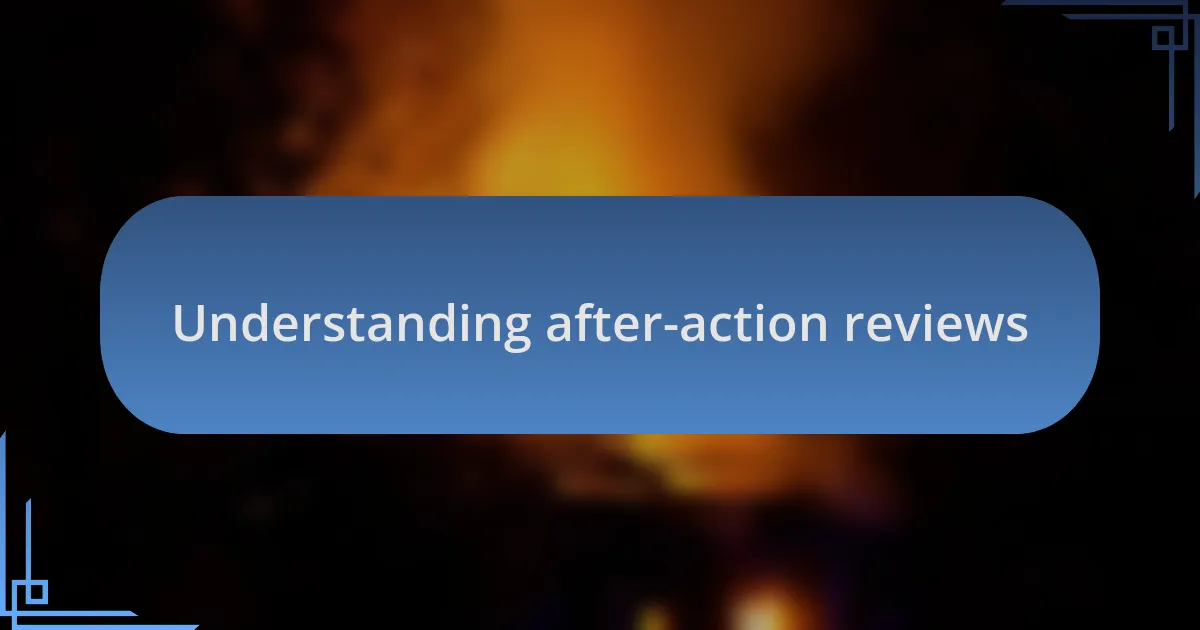
Understanding after-action reviews
After-action reviews (AARs) are critical tools in the firefighting world, allowing teams to reflect on their performance following an incident. When I first participated in an AAR, I was surprised by how much valuable feedback emerged from what felt like a chaotic day. It dawned on me then that these reviews are not simply a formality but an essential practice for growth and improvement.
Consider this: have you ever left a scene wondering if you could have done something differently? AARs address those lingering questions head-on. I vividly remember sitting down with my team after a challenging rescue operation, and as we shared our thoughts, I felt the weight of our experiences transforming into actionable insights. We learned not only from our successes but also from the mistakes, which ultimately made us a stronger unit.
The process of conducting AARs invites an open dialogue that fosters trust among team members. I recall an incident where a fellow firefighter hesitated to admit a misstep during a call. When we created a space where vulnerability was welcomed, it not only relieved his burden but also reinforced our commitment to learning collectively. Doesn’t that sense of camaraderie make you appreciate the value of these reviews even more?
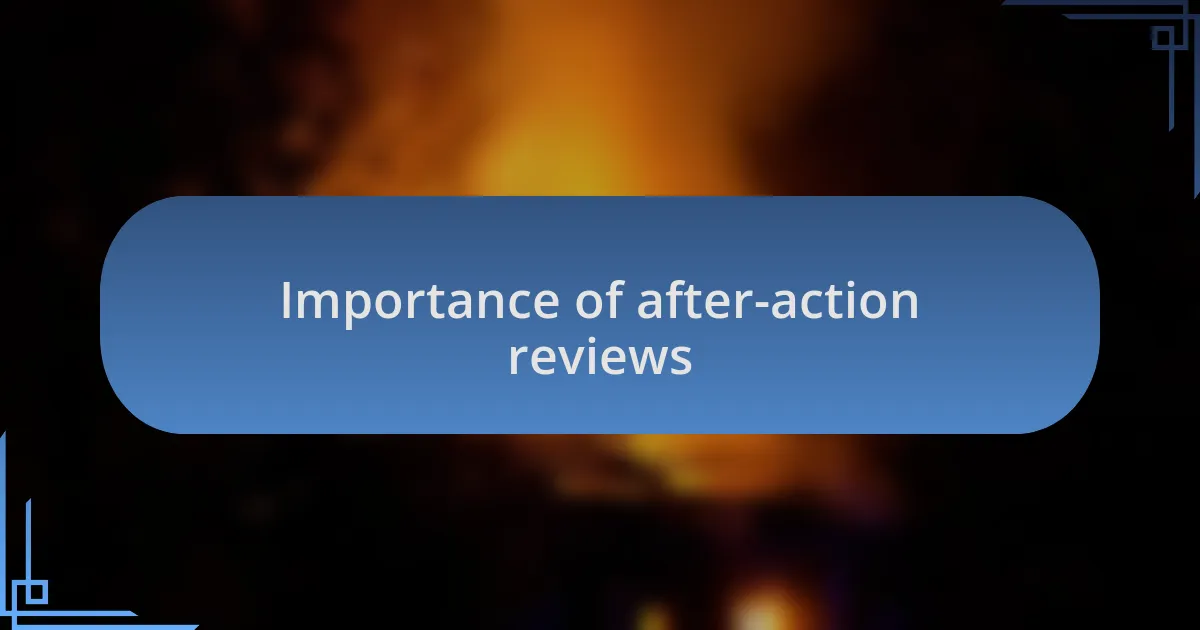
Importance of after-action reviews
After-action reviews are vital because they turn a one-time incident into a learning opportunity. I remember a particularly tough situation where my team faced unexpected obstacles, leaving us questioning our decisions. By sitting down together afterward, we not only dissected our actions but also uncovered new strategies that would better prepare us for future calls.
These reviews create a platform for honest reflection and team growth. One time, while reviewing a challenging fire response, I was struck by how one small oversight led to greater complications. Sharing these insights helped us realize that even minor details matter significantly in crisis situations. Isn’t it interesting how those seemingly trivial moments can pave the way for significant improvements?
Moreover, AARs nurture a culture of accountability and continuous learning within the firefighting community. I felt a deep sense of relief and empowerment when my colleagues shared their perspectives during a review of a high-pressure operation. Instead of assigning blame, we focused on collective learning, leaving everyone feeling motivated to enhance their skills. How often do we encounter opportunities to evolve as a team like this? It’s moments like these that truly solidify the importance of after-action reviews.
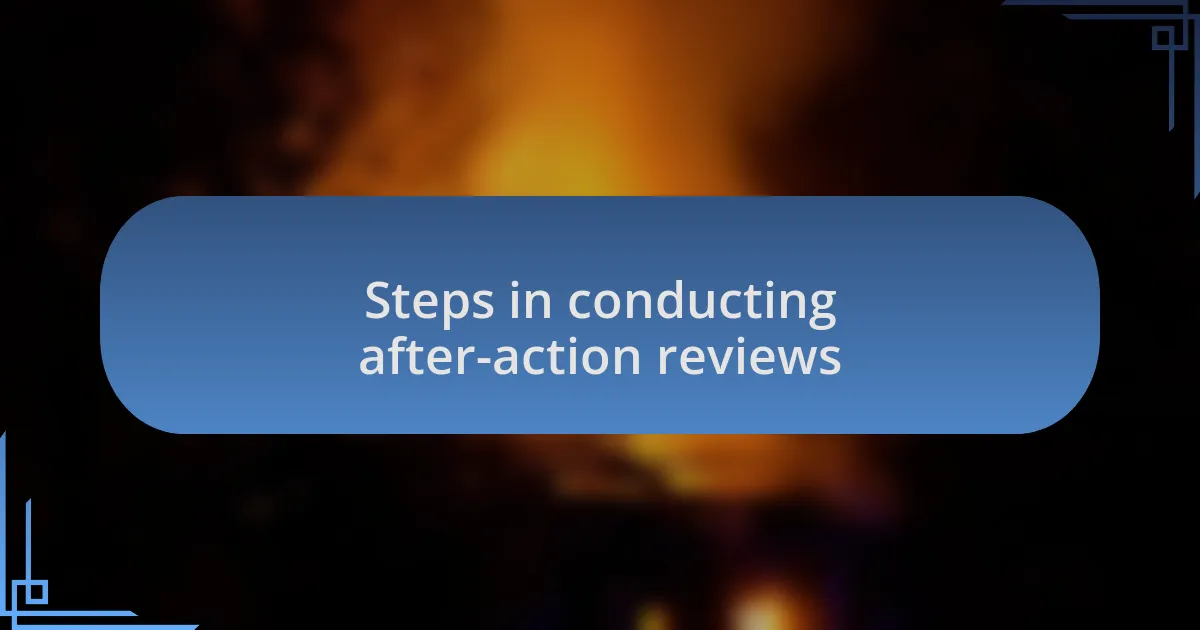
Steps in conducting after-action reviews
Conducting an after-action review (AAR) begins with gathering the entire team involved in the incident. I recall a time when we organized a review session right after a difficult wildfire response. The immediacy of the discussion allowed emotions to surface and real feelings to be shared, enriching the process. It’s amazing how valuable those raw impressions can be when everyone is still reeling from the experience.
Next, it’s crucial to create a safe space for open dialogue. I remember leading a session where the atmosphere was initially tense, but as we set ground rules for constructive feedback, the team began to share honestly. It was eye-opening to hear my colleagues’ perspectives. I realized that fostering respect and trust not only enhances communication but also encourages vulnerability, which is essential for genuine learning. What steps can we take to ensure that team members feel safe to speak up?
Finally, analyzing the gathered feedback is where the real magic happens. Recently, we reviewed the tactics from a rescue operation that didn’t go as planned. By breaking down what each member observed, we identified critical areas that needed improvement, such as communication breakdowns during the crisis. This reflective practice not only led to actionable strategies but deepened our understanding of each role within the team. It’s uplifting to think that these collaborative efforts shape our future responses. How powerful is it when we learn together in pursuit of excellence?
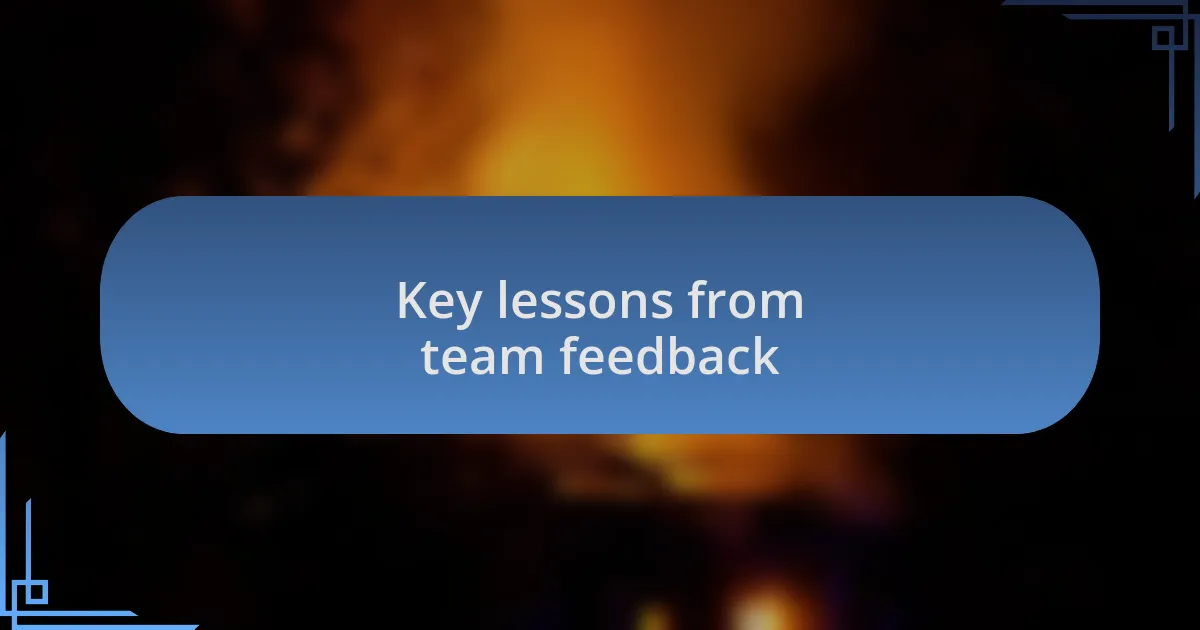
Key lessons from team feedback
When receiving team feedback, I’ve learned that every voice matters. In one review session, a junior firefighter raised a point about equipment placement during an incident. Initially, I was skeptical, but after discussing it as a team, we realized that her suggestion could enhance our efficiency in future operations. It’s a vivid reminder that insights can come from the most unexpected places; how often do we overlook valuable perspectives simply because of hierarchy?
Listening to feedback goes beyond dissecting what went wrong; it’s about celebrating what went right, too. I remember a particularly challenging drill where we executed our strategy flawlessly. Sharing that success reinforced our team’s strengths and boosted morale. Recognizing achievements can help cultivate a positive learning environment where team members feel motivated to contribute and improve. Isn’t it energizing to reflect on both our triumphs and our challenges together?
One of the most profound lessons I’ve gleaned is the importance of thematic analysis from feedback. After an exhausting night shift, our team found ourselves entrenched in a heated discussion about communication failures. By categorizing the feedback, we uncovered patterns that pointed to a lack of clarity in our pre-incident meetings. This experience underscored the necessity of clear protocols and left me pondering: how can we continue refining our approach to communication? Each feedback loop is an opportunity for growth, reinforcing the dynamics of our teamwork and ensuring we are always evolving.
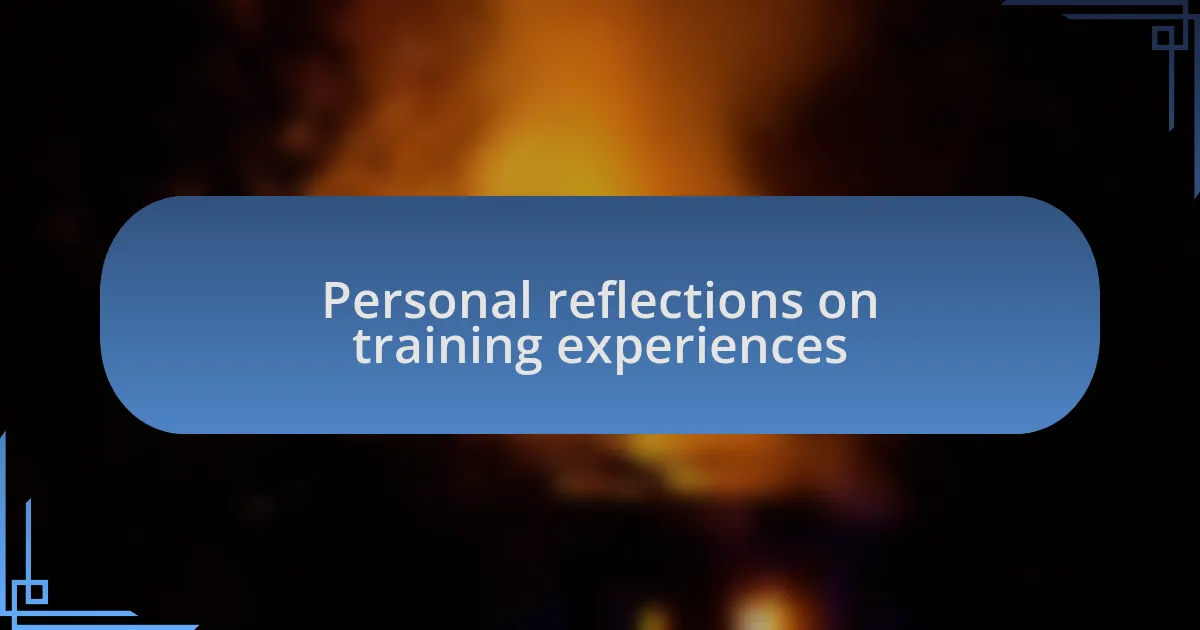
Personal reflections on training experiences
Reflecting on my training experiences, I’ve realized how much vulnerability plays a role in our growth as firefighters. During a drill, I stumbled while demonstrating a new technique, and instead of feeling embarrassed, I welcomed the feedback from my peers. That moment turned into a powerful lesson for me: we learn more from our mistakes than our successes. Isn’t it fascinating how a slip-up can pave the way to improvement?
I’ve also found that training sessions can be emotional roller coasters. I remember a time when we performed an intricate rescue simulation. Although we executed the maneuvers correctly, the weight of the situation hit me hard. The realization of how quickly lives can change left me with a deeper respect for our role. How often do we take a step back to appreciate the seriousness behind our training? That experience reinforced my commitment to mastering my skills and supporting my teammates.
Another impactful training experience was when we participated in a cross-department exercise. I noticed how different styles of training led to unique perspectives and strategies. It prompted me to think about how adaptable we need to be in our practices. I came away feeling inspired and grateful for the diversity in approaches and the opportunity to learn from others. Have you ever considered how collaboration can amplify our training effectiveness? It’s a reminder that we’re all in this together, growing stronger as we share our experiences.
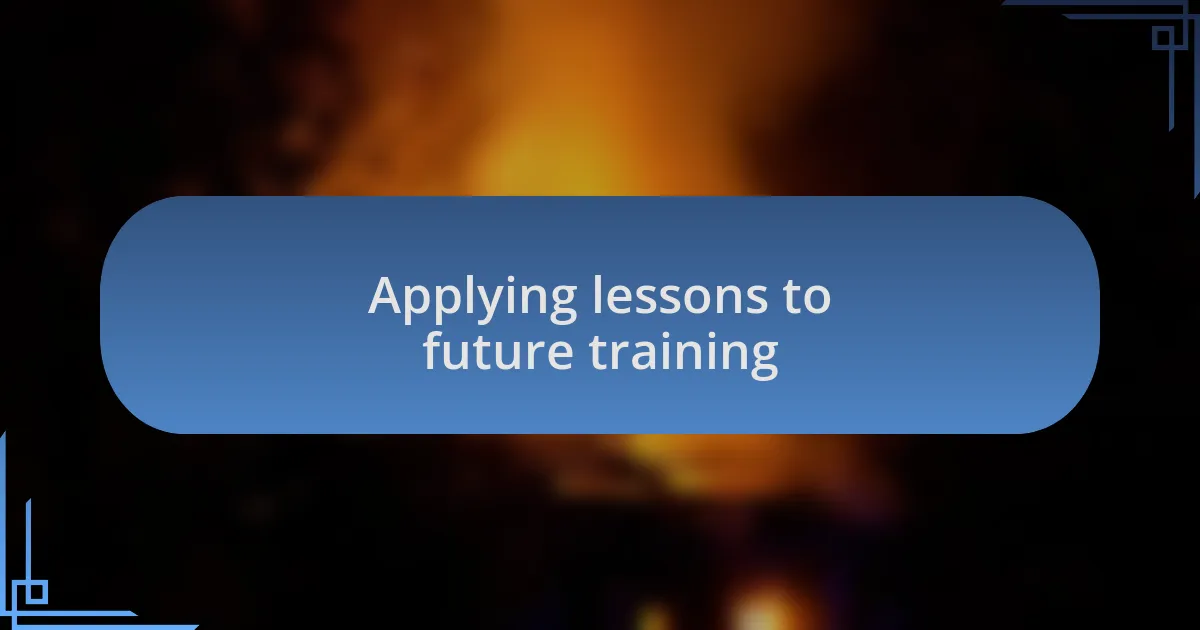
Applying lessons to future training
One of the most important ways I apply lessons from After Action Reviews is by refining our training techniques. After a particularly challenging incident, we reviewed our approach and identified a gap in our communication during high-pressure situations. This understanding prompted me to suggest incorporating scenario-based drills focused specifically on communication, ensuring we are prepared to convey critical information clearly when it matters most. Isn’t it interesting how a small change in training focus can lead to substantial improvements in real-life responses?
Reflecting on past corrections has also inspired me to embrace flexibility in our training sessions. During a recent review, we noted that certain tactics weren’t working as anticipated, so I took it upon myself to introduce new methods, blending some fresh insights I’ve gained from attending workshops. It’s a reminder that as we learn, our training should evolve with us. Have you ever thought about how staying adaptable can enhance our skills?
Moreover, I’ve grown to appreciate the role of emotional intelligence in our training. After a particularly emotional debriefing session, where we discussed the impact of stress on decision-making, I realized the importance of addressing mental resilience in our drills. Now, I advocate for including mindfulness techniques in our training to help fellow firefighters manage stress better on the job. How often do we consider the psychological aspects of firefighting in our practical exercises? Emphasizing this vital component can greatly improve our overall effectiveness as a team.
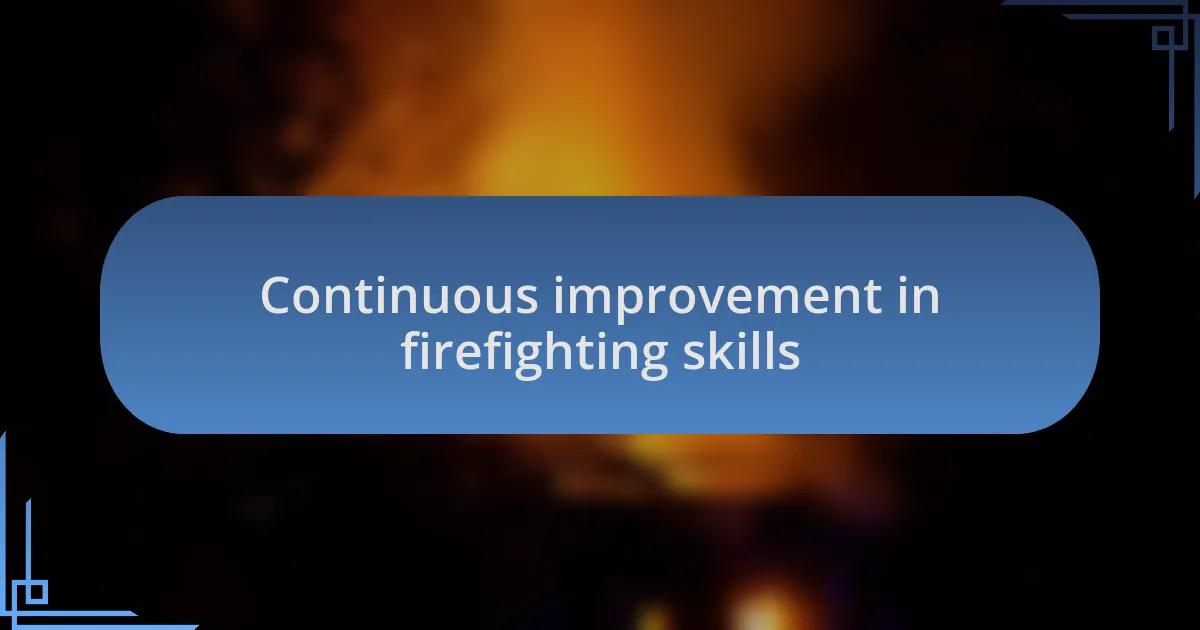
Continuous improvement in firefighting skills
When I reflect on my journey as a firefighter, I can’t help but notice how the constant push for improvement shapes our skills. I vividly recall a drill where we struggled with ladder placement during a simulated rescue. That experience was eye-opening—it made me realize that even basic skills can fall short under pressure. So, I initiated a series of mini-training sessions focused solely on ladder techniques, ensuring we don’t just practice but master those crucial fundamentals. Isn’t it fascinating how revisiting the basics can elevate our performance?
I also believe that sharing experiences plays a vital role in refining our abilities. After one particularly intense call, I gathered my team to discuss what worked and what didn’t. Open conversations sparked new ideas, and I was surprised to learn that a simple technique some had been using could streamline our approach. This interaction reinforced my belief that collaboration doesn’t just enhance our skills; it fosters a culture of learning that keeps us all sharp. How often do we overlook the power of peer learning in our training endeavors?
Moreover, the impact of feedback is often underestimated in our profession. I recently had a mentor who made it a point to catch up with me after a challenging shift. He encouraged me to reflect not just on my technical skills but on my interactions with the team. That conversation was invaluable; it reminded me that our growth isn’t just about firefighting techniques but also about becoming better communicators and teammates. Doesn’t it make sense that nurturing these soft skills alongside our hard skills can amplify our effectiveness in the field?